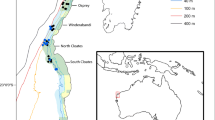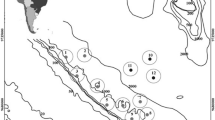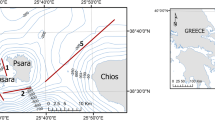Abstract
In polar areas, where benthic sampling is constrained by a series of limitations imposed by climate and logistic challenges, knowledge about the key elements required to plan a successful survey is fundamental. During the International Polar Year (IPY, 2007/2008), under the Census of Antarctic Marine Life (CAML), new sampling campaigns were undertaken in several Antarctic areas comprising the Ross Sea. In this region, the 2008 NIWA IPY-CAML voyage obtained benthos samples from shelf to abyssal depths. In the present study, we focus on the Mollusca from this expedition and on the possible variations in their richness and composition with latitude and depth. Given the use of sampling gears selective for different size fractions of the macrofauna, we also assess which size fraction contained the highest biodiversity. Differences were detected in species composition with latitude (averaged across depth groups) but not for depth (averaged across latitudinal groups). Richness varied locally and showed a variety of patterns depending on the areas and depths considered. The greatest diversity of molluscs was found in the fine fraction (i.e., <4.1 mm) where a considerable number of species corresponded to new species or new regional records. Rarity was high with up to ~41% of species represented by single individuals and ~63% occurring at one station only. Fine-mesh trawling appears to be of fundamental importance in accelerating the census of the fine fraction, which is the one containing the highest diversity, and is recommended for future sampling in Antarctica and in polar areas in general.






Similar content being viewed by others
References
Albano PG, Sabelli B, Bouchet P (2011) The challenge of small and rare species in marine biodiversity surveys: microgastropod diversity in a complex tropical coastal environment. Biodivers Conserv 20:3223–3237
Bardou P, Mariette J, Escudié F, Djemiel C, Klopp C (2014) jvenn: an interactive Venn diagram viewer. BMC Bioinformatics 15:1. doi:10.1186/1471-2105-15-293
Barry JP, Grebmeier JM, Smith J, Dunbar RB (2003) Oceanographic Versus Seafloor-Habitat Control of Benthic Megafaunal Communities in the SW Ross Sea, Antarctica. In: Ditullio GR, Dunbar RB (eds.) Biogeochemistry of the Ross Sea. American Geophysical Union, Washington, pp 327–353
Błażewicz-Paszkowycz M, Siciński J (2014) Diversity and distribution of Tanaidacea (Crustacea) along the Victoria Land Transect (Ross Sea, Southern Ocean). Polar Biol 37:519–529. doi:10.1007/s00300-014-1452-7
Bouchet P, Lozouet P, Maestrati P, Heros V (2002) Assessing the magnitude of species richness in tropical marine environments: exceptionally high numbers of molluscs at a New Caledonia site. Biol J Linn Soc 75:421–436. doi:10.1046/j.1095-8312.2002.00052.x
Bowden DA, Schiaparelli S, Clark MR, Rickard GJ (2011) A lost world? Archaic crinoid-dominated assemblages on an Antarctic seamount. Deep-Sea Res Part II 58:119–127. doi:10.1016/j.dsr2.2010.09.006
Bracegirdle T, Stephenson D (2012) Higher precision estimates of regional polar warming by ensemble regression of climate model projections. Clim Dynam 38:2805–2821. doi:10.1007/s00382-012-1330-3
Brandt A (1995) Peracarid fauna (Crustacea, Malacostraca) of the Northeast Water Polynya off Greenland: documenting close benthic-pelagic coupling in the Westwind Trough. Mar Ecol-Prog Ser 121:39–51. doi:10.3354/meps121039
Brandt A, De Broyer C, Gooday AJ, Hilbig B, Thomson MR (2004) Introduction to ANDEEP (ANtarctic benthic DEEP-sea biodiversity: colonization history and recent community patterns) a tribute to Howard Sanders. Deep-Sea Res Part II 51:1457–1465. doi:10.1016/j.dsr2.2004.08.006
Brandt A et al (2013) Epifauna of the Sea of Japan collected via a new epibenthic sledge equipped with camera and environmental sensor systems. Deep-Sea Res Part II 86:43–55. doi:10.1016/j.dsr2.2012.07.039
Brandt A et al (2014) Composition and abundance of epibenthic-sledge catches in the South Polar Front of the Atlantic. Deep-Sea Res Part II 108:69–75. doi:10.1016/j.dsr2.2014.08.017
Brandt A, Elsner NO, Malyutina MV, Brenke N, Golovan OA, Lavrenteva AV, Riehl T (2015) Abyssal macrofauna of the Kuril–Kamchatka Trench area (Northwest Pacific) collected by means of a camera–epibenthic sledge. Deep-Sea Res Part II 111:175–187. doi:10.1016/j.dsr2.2014.11.002
Brenke N (2005) An epibenthic sledge for operations on marine soft bottom and bedrock. Mar Technol Soc J 39:10–21. doi:10.4031/002533205787444015
Chao A, Jost L (2012) Coverage-based rarefaction and extrapolation: standardizing samples by completeness rather than size. Ecology 93:2533–2547. doi:10.1890/11-1952.1
Chao A, Gotelli NJ, Hsieh TC, Sander EL, Ma K, Colwell RK, Ellison AM (2014) Rarefaction and extrapolation with Hill numbers: a framework for sampling and estimation in species diversity studies. Ecol Monograph 84:45–67. doi:10.1890/13-0133.1
Chao A, Ma KH, Hsieh TC (2016) iNEXT (iNterpolation and EXTrapolation) Online. http://chao.stat.nthu.edu.tw/wordpress/software_download/. Accessed 20 March 2017
Clark MR, Stewart R (2016) The NIWA seamount sled: An effective epibenthic sledge for sampling epifauna on seamount and rough seafloor. Deep-Sea Res Part II 108:32–38
Clarke KR (1993) Non parametric multivariate analyses of changes in community structure. Aust J Ecol 18:117–143. doi:10.1111/j.1442-9993.1993.tb00438.x
Clarke KR, Gorley RN (2005) PRIMER. Getting started with v6 PRIMER-E Ltd, Plymouth
Clarke A, Johnston NM (2003) Antarctic marine benthic diversity. Oceanogr. Mar Biol 41:47–114
Clarke A, Griffiths HJ, Linse K, Barnes DK, Crame JA (2007) How well do we know the Antarctic marine fauna? A preliminary study of macroecological and biogeographical patterns in Southern Ocean gastropod and bivalve molluscs. Divers Distrib 13:620–632. doi:10.1111/j.1472-4642.2007.00380.x
Colwell RK, Chao A, Gotelli NJ, Lin S-Y, Mao CX, Chazdon RL, Longino JT (2012) Models and estimators linking individual-based and sample-based rarefaction, extrapolation and comparison of assemblages. J Plant Ecol 5:3–21. doi:10.1093/jpe/rtr044
Cummings V, Thrush S, Chiantore M, Hewitt J, Cattaneo-Vietti R (2010) Macrobenthic communities of the north-western Ross Sea shelf: links to depth, sediment characteristics and latitude. Antarct Sci 22:793–804. doi:10.1017/S0954102010000489
Dell RK (1990) Antarctic Mollusca. With special reference to the fauna of the Ross Sea. J R Soc N Z Bull 27:1–311
Eléaume M, Hemery LG, Bowden DA, Roux M (2011) A large new species of the genus Ptilocrinus (Echinodermata, Crinoidea, Hyocrinidae) from Antarctic seamounts. Polar Biol 34:1385–1397. doi:10.1007/s00300-011-0993-2
Gaston KJ, Williams PH (1993) Mapping the world’s species-the higher taxon approach. Biodivers Lett. doi:10.2307/2999642
Ghiglione C, Alvaro MC, Griffiths H, Linse K, Schiaparelli S (2013) Ross Sea Mollusca from the latitudinal gradient program: R/V Italica 2004 Rauschert dredge samples. ZooKeys 341:37–48. doi:10.3897/zookeys.341.6031
Griffiths HJ, Linse K, Crame JA (2003) SOMBASE–Southern Ocean Mollusc Database: a tool for biogeographic analysis in diversity and ecology. Org Divers Evol 3:207–213. doi:10.1078/1439-6092-00079
Griffiths HJ, Danis B, Clarke A (2011) Quantifying Antarctic marine biodiversity: The SCAR-MarBIN data portal. Deep-Sea Res Part II 58:18–29. doi:10.1016/j.dsr2.2010.10.008
Hanchet S, Mitchell J, Bowden D, Clark M, Hall J, O’Driscoll R (2008) Ocean survey 20/20 NZ IPY-CAML: final voyage report. NIWA Client Report WLG2008-74
Hessler R, Sanders ML (1967) Faunal diversity in the deep sea. Deep-Sea Res Oceanogr Abstr 14:65–78. doi:10.1016/0011-7471(67)90029-0
Hilbig B (2004) Polychaetes of the deep Weddell and Scotia Seas – composition and zoogeographical links. Deep-Sea Res Part II 51:1817–1825
IPCC (2013) Climate change: the physical science basis. Contribution of Working Group I to the Fifth Assessment Report of the Intergovernmental Panel on Climate Change. Cambridge University, Cambridge
Jörger K, Schrödl M, Schwabe E, Würzberg L (2014) A glimpse into the deep of the Antarctic Polar Front–Diversity and abundance of abyssal molluscs. Deep-Sea Res Part II 108:93–100. doi:10.1016/j.dsr2.2014.08.003
Kaiser S, Barnes DKA, Linse K, Brandt A (2008) Epibenthic macrofauna associated with the shelf and slope of a young and isolated Southern Ocean Island. Antarct Sci 20:281–290
Kaiser S, Barnes DKA, Sands CJ, Brandt A (2009) Biodiversity of an unknown Antarctic Sea: assessing isopod richness and abundance in the first benthic survey of the Amundsen continental shelf. Mar Biodiv 39:27–43
Kennicutt M et al (2015) A roadmap for Antarctic and Southern Ocean science for the next two decades and beyond. Antarct Sci 27:3–18. doi:10.1017/S0954102014000674
Linse K (2004) Scotia Arc deep-water bivalves: composition, distribution and relationship to the Antarctic shelf fauna. Deep-Sea Res Part II 51:1827–1837
Linse K, Brandt A (1998) Distribution of Epibenthic Molluscs on a Transect Through the Beagle Channel (Southern Chile). J Mar Bio Assoc UK 78:875–889
Longino JT, Coddington J, Colwell RK (2002) The ant fauna of a tropical rain forest: estimating species richness three different ways. Ecology 83:689–702. doi:10.1890/0012-9658(2002)083[0689:TAFOAT]2.0.CO;2
Lörz A-N, Kaiser S, Bowden D (2013) Macrofaunal crustaceans in the benthic boundary layer from the shelf break to abyssal depths in the Ross Sea (Antarctica). Polar Biol 36:445–451. doi:10.1007/s00300-012-1269-1
McClain CR (2004) Connecting species richness, abundance and body size in deep-sea gastropods. Glob Ecol Biogeogr 13:327–334. doi:10.1111/j.1466-822X.2004.00106.x
Mitchell J, Clark M (2004) Voyage Report Tan04–02. Western Ross Sea Voyage, pp 1–102
Pabis K, Jóźwiak P, Lörz A-N, Schnabel K, Błażewicz-Paszkowycz M (2015) First insights into the deep-sea tanaidacean fauna of the Ross Sea: species richness and composition across the shelf break, slope and abyss. Polar Biol 38:1429–1437. doi:10.1007/s00300-015-1706-z
Piazza P, Błażewicz-Paszkowycz M, Ghiglione C, Alvaro MC, Schnabel K, Schiaparelli S (2014) Distributional records of Ross Sea (Antarctica) Tanaidacea from museum samples stored in the collections of the Italian National Antarctic Museum (MNA) and the New Zealand National Institute of Water and Atmospheric Research (NIWA). ZooKeys 451:49–60. doi:10.3897/zookeys.451.8373
Piazza P, Alvaro MC, Bowden DA, Clark MR, Conci N, Ghiglione C, Schiaparelli S (2015) First record of living Acesta (Mollusca: Bivalvia) from an Antarctic seamount. Mar Biodiv 46:529–530. doi:10.1007/s12526-015-0397-6
Rehm P, Thatje S, Mühlenhardt-Siegel U, Brandt A (2007) Composition and distribution of the peracarid crustacean fauna along a latitudinal transect off Victoria Land (Ross Sea, Antarctica) with special emphasis on the Cumacea. Polar Biol 30:871–881. doi:10.1007/s00300-006-0247-x
Scambos T, Haran T, Fahnestock M, Painter T, Bohlander J (2007) MODIS-based Mosaic of Antarctica (MOA) data sets: continent-wide surface morphology and snow grain size. Remote Sens Environ 111:242–257. doi:10.1016/j.rse.2006.12.020
Schiaparelli S, Lörz A-N, Cattaneo-Vietti R (2006) Diversity and distribution of mollusc assemblages on the Victoria Land coast and the Balleny Islands, Ross Sea, Antarctica. Antarct Sci 18:615–631. doi:10.1017/S0954102006000654
Schiaparelli S, Danis B, Wadley V, Stoddart DM (2013) The census of Antarctic marine life: the first available baseline for Antarctic marine biodiversity. In: Verde C, di Prisco G (eds.) Adaptation and evolution in marine environments, Vol 2. Springer, Berlin Heidelberg, pp 3–19
Schiaparelli S, Ghiglione C, Alvaro MC, Griffiths HJ, Linse K (2014) Diversity, abundance and composition in macrofaunal molluscs from the Ross Sea (Antarctica): results of fine-mesh sampling along a latitudinal gradient. Polar Biol 37:859–877. doi:10.1007/s00300-014-1487-9
Schwabe E, Bohn JM, Engl W, Linse K, Schrödl M (2007) Rich and rare - First insights into species diversity and abundance of Antarctic abyssal Gastropoda (Mollusca). Deep-Sea Res Part II 54:1831–1847. doi:10.1016/j.dsr2.2007.07.010
Souza JLP, Baccaro FB, Landeiro VL, Franklin E, Magnusson WE, Pequeno PACL, Fernandes IO (2016) Taxonomic sufficiency and indicator taxa reduce sampling costs and increase monitoring effectiveness for ants. Divers Distrib 22:111–122
Acknowledgements
We would like to acknowledge the crew of the Tangaroa ‘IPY-CAML TAN0802’ for logistic support. We are indebted to the New Zealand Ministry of Fisheries (MFish) and NIWA (Wellington) for the financial support of the cruise and related study activities. We are indebted to Laura D’Annibale for sorting operations at the Italian National Antarctic Museum (Section of Genoa). We thank the Italian PNRA for the financial support to the research program BAMBi (Barcoding of Antarctic Marine Biodiversity, PNRA 2010/A1.10).
Author information
Authors and Affiliations
Corresponding author
Electronic supplementary material
Below is the link to the electronic supplementary material.
300_2017_2117_MOESM3_ESM.tif
Numbers of species and specimens collected by each gear divided per mollusc class. Abbreviations: BIV = Bivalvia; GAS = Gastropoda; MON = Monoplacophora; POL = Polyplacophora; SCA = Scaphopoda; SOL = Solenogastres (TIF 32543 KB)

300_2017_2117_MOESM5_ESM.jpg
Richness rarefaction and extrapolation analyses performed with iNEXT on incidence data (Brenke sled data only) for the bathymetric classes considered (JPG 1102 KB)
Rights and permissions
About this article
Cite this article
Ghiglione, C., Alvaro, M.C., Piazza, P. et al. Mollusc species richness and abundance from shelf to abyssal depths in the Ross Sea (Antarctica): the importance of fine-mesh-towed gears and implications for future sampling. Polar Biol 40, 1989–2000 (2017). https://doi.org/10.1007/s00300-017-2117-0
Received:
Revised:
Accepted:
Published:
Issue Date:
DOI: https://doi.org/10.1007/s00300-017-2117-0




